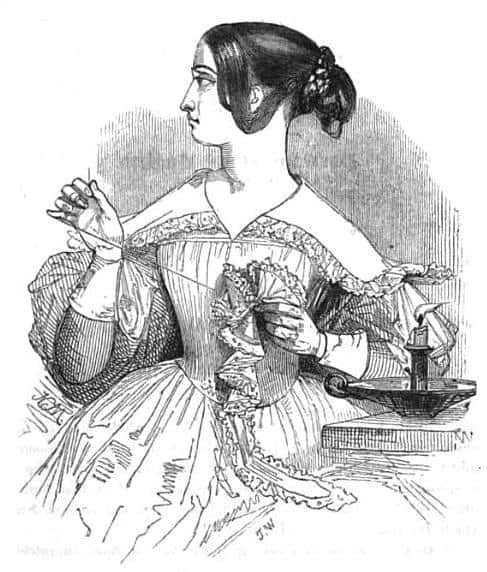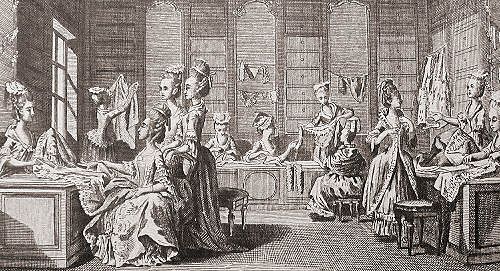Hi there my loves!
We have all read a book or two, or ten, where our favorite heroine requires a new gown. But have you ever imagined the amount of work it took to make such a gown when everything was hand sewn, and the extremely talented women behind those stitches?
Well imagine that it is the Season in London and young ladies and their mamas are ordering dresses by the dozens for balls and visits. In an age when all sewing and embroidery were done by hand, when lighting was poor and wages were so low that they barely paid for room and board, pity the poor seamstress hunched over her sewing assignments, racing against time to meet a series of deadlines that seem endless, and complying with the exacting standards of a boss and clients who cared not a whit for her comfort.
Let’s take a look at what went on behind the scenes of a modiste’s shop.
A London modiste would have MANY seamstresses working for her. Around the middle of the 19th century, the average modiste employed around 20 seamstresses. By 1870, when his business was really taking off, Charles Worth employed 1200, turning out thousands of extremely elaborate dresses a year. In an emergency, they could put together a simple gown for an important client in less than a day from scratch. And they would work late into the night, or through the night, if need be, to please a regular client or a client of whom they were very fond.
The amount of work a dressmaker has and the number of seamstresses employed determine how long it took to make a garment. Of course, the trimming and such also matters. A court dress could well take five days if the seamstresses worked on nothing else. If one needed a garment made expeditiously, one could pay extra, and it could usually be done.


Image source: janeaustensworld.wordpress.com
A London dress maker could usually make one faster than a village seamstress, though even a village seamstress could finish a simple dress in three days if she had no other work.
There were no printed patterns so the lady and the dressmaker would have to confer on the dress’s style and the choice of fabric. If the lady had never been to the store before, she would be measured and an unfinished muslin or linen mock up dress would be made and fitted to her. The most skilled part of the procedure was drawing off the pieces and then cutting them properly. The dressmaker had to be able to see the pattern behind the fashion illustrations.
The muslin pieces would be used as pattern pieces when the material was cut. Then the fabric pieces would be pinned together. Many seamstresses then basted the seams. All this is the time consuming part. The customer was supposed to come for the final fitting wearing the stays she would wear with the dress. Dress makers did not usually make the stays. The dress would be tried on and any final adjustments made.
Small adjustments after a final fitting likely took less than an hour, depending on the amount of work that needed to be done. All measurements would have been made before starting the gown, so there would be only tiny adjustments.
Then seamstresses would sew all the seams and add any trimmings and tidy up the gown. The dress/gown was customarily pressed by the woman’s lady maid, not by the modiste’s workers.
Fingers numb, backs aching, eyes straining to focus on mind numbingly repetitive work meant that burning the midnight oil was no mere phrase. For embroiderers who continued to work well past dusk, lamps were devised that amplified light. Those who sat closest to its source benefited the most. The poor women who sat in the outer circle scarcely benefited from the amplification of lacemaker lamps
Owning a shop was no guarantee of economic stability, for many wealthy women failed to pay their bills on time, if at all. In the 18th century, the enterprising Hannah Glasse ran a dressmaker’s shop in London with her daughter, which eventually went bankrupt. She went on to write one of the most popular cookbooks of her era, but in this venture she too lost money.


Image source: janeaustensworld.wordpress.com
As the century progressed and with the advent of the sewing machine, life did not automatically become easier for seamstresses and dressmakers, who still worked long hours in cramped conditions, their backs bent over sewing machines in factories and piece work shops. Clothing had become more affordable. The rising middle class was purchasing more items than ever, and etiquette dictated that wealthy ladies were required to change their clothes for different functions throughout the day. Thus demand for new and fashionable clothes remained high.


Image source: Pinterest
Can you even imagine all that hard work? My eyes are hurting just thinking about it… I tip my hat to those talented women and their nimble fingers!
If you have any questions and/or comments darlings feel free to write to me below!
All my love,
Written byEmma Linfield



